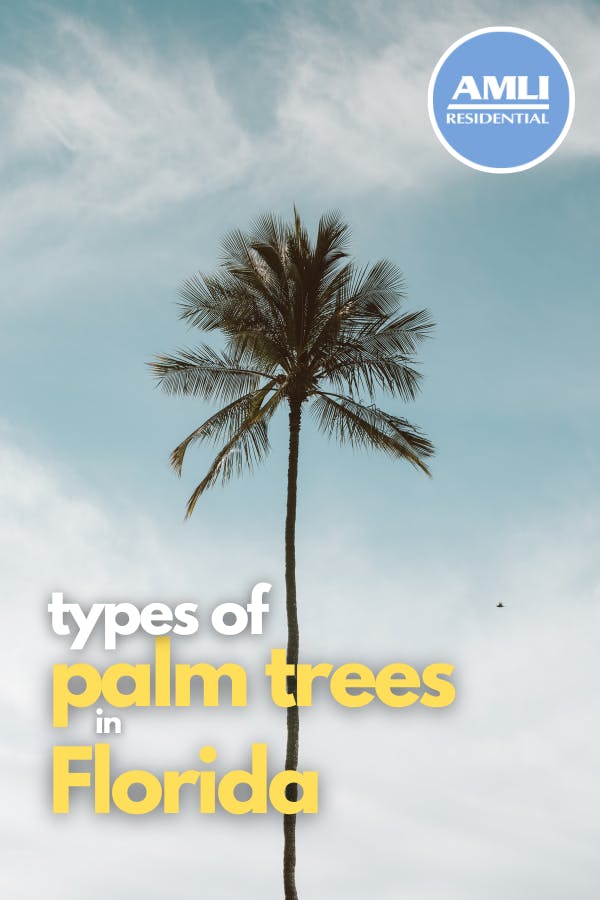Florida is a paradise dotted with gorgeous palms silhouetted against the ocean sunshine. There are so many palms, in fact, that it can be tricky to figure out which one is which.
Here are just a few of the more common ones you can see around South Florida and our luxury South Florida apartments!
Common palms in Florida
Bismarck palm
Bismarckia nobilis
Bismarck palms can grow up to 70 feet tall in their native Madagascar, but they are more commonly found in the 30-60 foot range here in Florida. They have a single, smooth trunk that is topped with a crown of fan-shaped leaves which are 4-6 feet wide and have a silvery-blue sheen that is particularly striking in full sun.
Bottle palm
Hyophorbe lagenicaulis
Also known as the palmiste gargoulette, the bottle palm is a slow-growing palm tree that is native to the Mascarene Islands in the Indian Ocean but has since become a popular ornamental plant in Florida.
These palms have a smooth, gray trunk that is swollen at the base, giving it the appearance of a bottle. The trunk is topped with a crown of arching, pinnate fronds that can reach up to 12 feet long, though the entire tree usually stays under 20 feet tall.
Cabbage palm / sabal palm
Sabal palmetto
The cabbage palm, also known as the sabal palm, is the state tree of Florida and South Carolina and is found extensively throughout the southeast coastal areas. They’re recognizable by their tall, smooth trunks topped with dense clusters of palm fronds.
The cabbage palm is named for its edible immature leaves, or "heart," which has a cabbage-like flavor. The heart of palm is a popular food in Florida and is often used in salads, soups and stews.
Cabbage palms are also used for a variety of other purposes; the trunks can be used to make furniture and other objects, and the leaves can be used to make thatch roofs and baskets. However, cabbage palms are protected by law in Florida and it is illegal to cut down a cabbage palm without a permit, so keep that in mind!
Canary Island date palm
Phoenix canariensis
Native to the Canary Islands where they grow up to 50 feet tall, these palms typically grow shorter here in Florida where they have been cultivated for several decades. The fronds are long, green and feathery and its trunk is thick, wide and covered with pineapple-like sections, giving the tree the nickname "pineapple palm!"
The date-like fruits that lend the tree its name are technically edible, but they don’t taste very good and aren’t used in any dishes or recipes.
Chinese fan palm
Livistona chinensis
Also known as the fountain palm, the Chinese fan palm is native to China and southern Japan, but it has been cultivated in Florida for many years where its become a popular landscaping species.
These palms have a single, smooth trunk that is topped with a crown of fan-shaped leaves. The leaves are 3-4 feet across, have a dark green color and thin leaf tips that droop down gracefully, giving the tree a fountain-like appearance that looks stunning at any height.
Coconut palm
Cocos Nucifera
The coconut palm is a tall, single-trunked palm tree that is native to tropical regions around the world. It is the most economically important palm tree and is grown for its coconuts, which are used for food, beverage and other products all over the globe — including here in Florida!
Florida royal palm
Roystonea regia
This easily identifiable palm can be recognized by its whitish-graying trunk that bulges in places, giving each tall, straight tree a unique silhouette. The trunks can grow up to 80 feet tall, and the long, green fronds themselves can grow up to 15 feet long, too, so make sure a frond doesn’t fall on you when you walk underneath one of these stunning trees!
Foxtail palm
Wodyetia bifurcata
The foxtail palm is a fast-growing palm tree that is native to northeastern Australia but has become a popular choice for landscaping in Florida.
The best way to identify these palms is by their fronds, which are thick, bushy and resemble a fox’s tail! Hence, the name.
Mexican fan palm
Washingtonia robusta
Also known as Mexican washingtonia or skyduster, the Mexican fan palm is a fast-growing palm tree that is native to the southwestern United States and northern Mexico, so it’s no wonder that it grows so well here in Florida.
These palms have long, skinny trunks that seem to reach high into the atmosphere, sending their brushy, leafy fronds to sweep the clouds — hence the cool name "skyduster."
Paurotis palm
Acoelorrhaphe wrightii
The paurotis palm, also known as the Everglades palm or Madeira palm, is a slow-growing palm tree that is native to Florida, the Caribbean and Central America where it grows in a variety of wet and dry conditions.
Like many palms, the paurotis palm features a single, slender trunk topped with fan-shaped leaves that are wispy with a light green color. The flowers are small and white and are followed by small, orange fruits, though they are only edible to the small birds and mammals that nest in the fronds.
Pindo palm
Butia capitata
These pretty palms are recognizable by their thick, woody trunks and long, thin, sage-green palm fronds that droop down. They are also one of the few palms in Florida that have edible fruits, and many people like to make jellies and jams with the small, orange fruits. As such, many call this tree the jelly palm!
From the Gulf to the Atlantic and everywhere in between, Florida’s palms grace the roadsides, beaches and marshes with stunning foliage and leafy beauty. Next time you’re out and about, keep an eye out for these palms and see how many of them you can spot!!
Pin it!

Featured photo courtesy Pixabay/sasint


 View All Posts by Colleen Ford
View All Posts by Colleen Ford